How to choose the best wood flooring for kitchens
The best wood flooring for kitchens should be able to handle everything the space throws at it — from spills to steam. We explain how to choose one that works for you
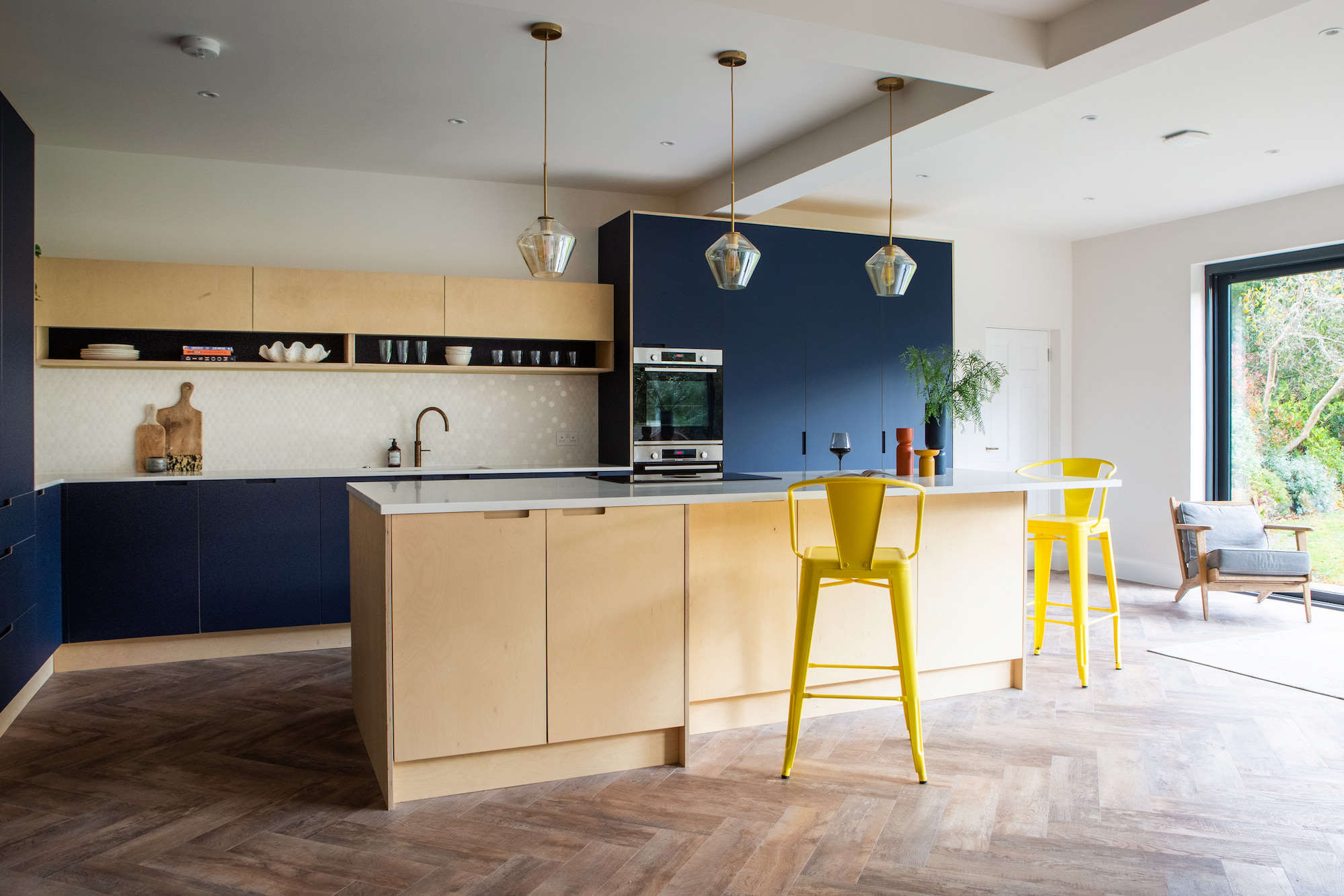
Kitchens are hard working spaces — so the best wood flooring for kitchens has to be able to keep up with them. There is also the small matter of the inevitable hot oil splatters and cooking spills to take into account, as well as high foot traffic, paw prints, dropping of sharp objects and scraping of stools and chairs.
So you can start to see why giving due attention to selecting the right types of flooring in this area of the house is so important. Of course, on top of all of this, the kitchen is the room in which we now rely on as a socialising space — which means it needs to look amazing too. Wooden flooring might be one of the most popular types of flooring but while it is undeniably beautiful to look at, it is not always the most practical choice — especially in spaces that are prone to fluctuating humidity levels and where hot, highly coloured and oily substances get flung about.
Here, we take a look at the best wood flooring types for kitchens so that you can have a floor that is both stylish as well as practical and low maintenance.
How to choose the best wood flooring for kitchens
Certain rooms of the house require you to put more thought into the materials you use in there than others. For example, when it comes to bathroom flooring, you need to be thinking about materials that can handle the odd flood, lots of humidity and be non-slip.
Likewise, when it comes to the best flooring for kitchens, you also need to be thinking about everything that goes on in the space and how your flooring is going to cope with it all. While it is true to say that, given enough of your time and care, any types of wood flooring could be fitted in a kitchen, some are going to be more suitable than others — particularly if you don’t want to dedicate too much of your time mopping, drying and reminding people to be careful with their drinks.
“As a natural material, wood flooring is the perfect pairing for all manner of kitchen styles," says Natalie Mudd, Creative Director at The Wood Flooring Co. "It can be the perfect finishing touch for classic Shaker-style kitchens, but can also add warmth and longevity to more modern, streamlined designs."
Here, we explain how to use wood flooring in the kitchen. You want to choose something ultra hard-wearing, easy-to-clean, resistant to all manner of substances, structurally stable and fabulous to look at. Is that really too much to ask?
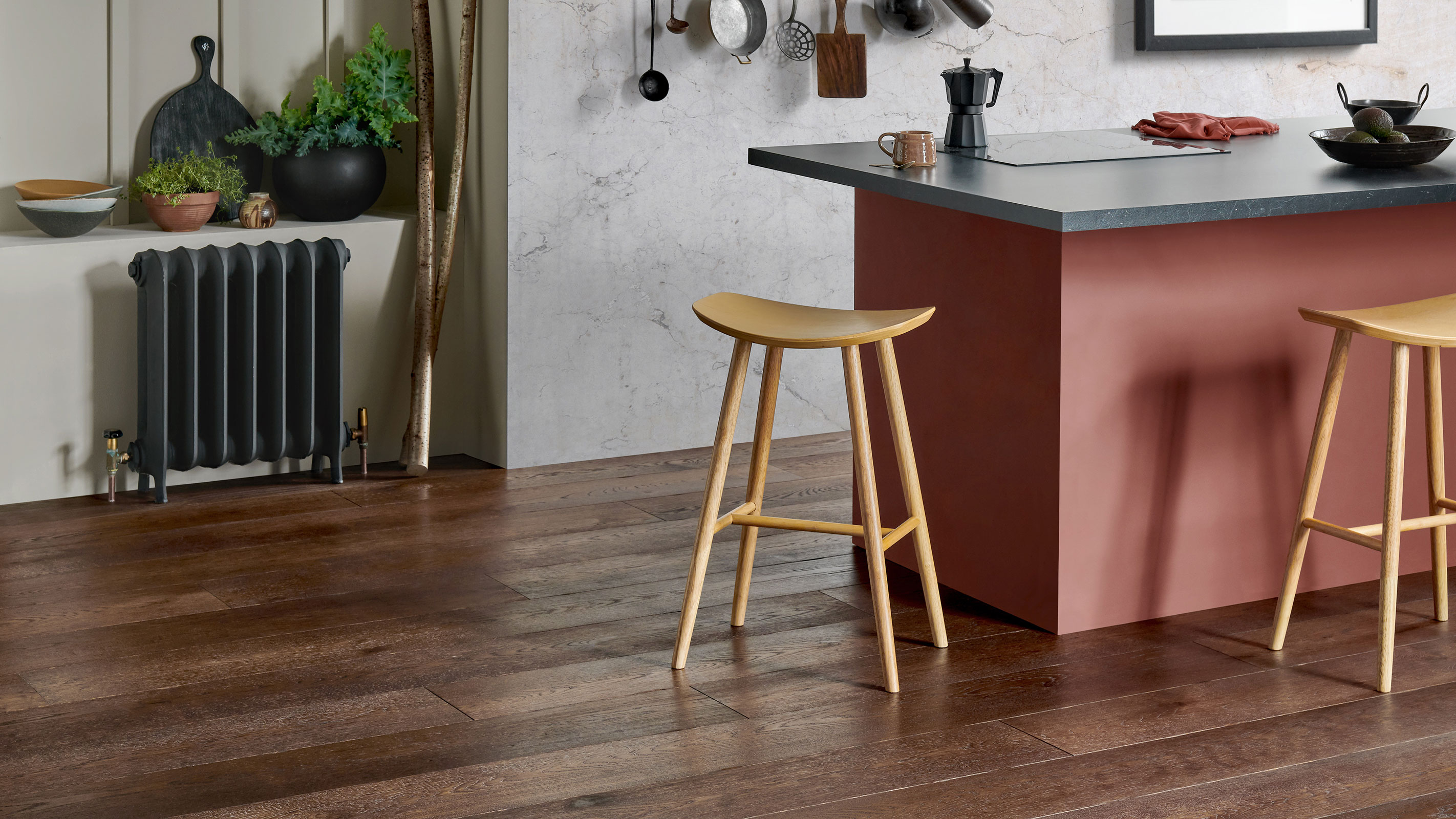
Play it safe with engineered wood rather than solid
The main decision you will be faced with when looking at types of wood flooring for your kitchen will be whether to opt for solid wood or an engineered wooden floor.
Most experts agree that engineered flooring wins hands down in this particular room thanks to its enhanced structural stability.
"Engineered wood is made up of various layers, which is what makes it far more durable and stable than a traditional solid wood floor, not to mention more sustainable," says Natalie Mudd. "The top layer on an engineered wood floor is made up entirely of solid wood (all of our floors have an oak top layer), which is bonded to a layer of incredibly strong plywood beneath and a stabilising counter layer. This layered design balances out the tensions in the wood and in turn prevents the wood from bending or swelling in areas of changing moisture, such as the kitchen."
“Engineered wood offers the best stability, due to its multi-layered construction," agrees Inga Morris-Blincoe, general manager at Lifestyle Floors. "This means that even when temperature and humidity vary with seasons or household activities, the floor will experience only minimal expansion and contraction when compared to solid wood floors. This makes engineered wood one of the most durable flooring types available.”
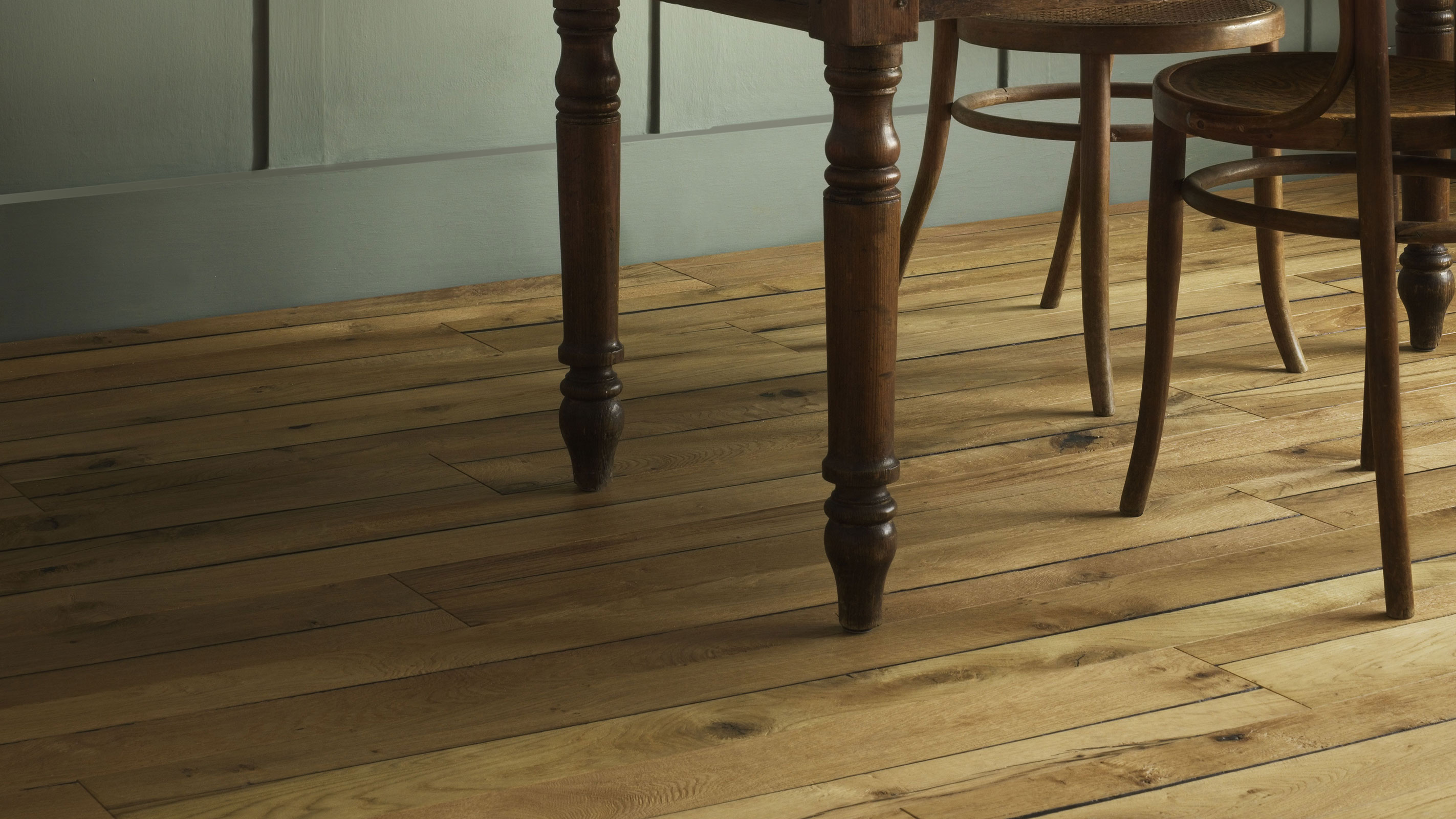
Opt for a lacquered finish in busy kitchens
While the experts tend to agree that engineered wood flooring is by far the better option for kitchen floors, the kind of finish you opt for will also play a part in how long it stays looking good and how much effort you have to put in when it comes to its upkeep.
"In high traffic areas such as a kitchen you may want to choose a lacquered surface, as it is easier to clean," says Inga Morris-Blincoe. "Lacquer also reflects more light, so may be ideal for smaller or darker rooms. However, an oiled floor can bring out the natural grain and colour of the floor, which you may prefer even though it will require more maintenance in the form of the regular reapplication of the oil finish."
Natalie Mudd also recommends a lacquered finish if durability is high on your list of priorities for your new floor. "For a kitchen floor, you may want to opt for a matt lacquer surface finish which will give a slightly tougher, more resilient finish," she says. "However, an oiled surface finish is the better option if you plan to sand or treat your wood flooring in the future.”
Choose a pale, simple wood floor in small kitchens
After small kitchen ideas to make the space feel bigger? The answer could lie in your choice of flooring — some will make the room feel more spacious than it really is more than others.
"Keep your flooring more streamlined — straight planks work well and can have the effect of making a space seem larger than it actually is," explains Natalie Mudd. "Smaller kitchens or galley styles work particularly well with straight wooden planks, which will add a sense of space and a smart finish to the room.”
The colour of the wood flooring you choose should also be given careful consideration — not only does it need to complement the shades you have used elsewhere in the space, on walls and units, for example, but it can also have an effect on how big the room seems.
“When it comes to choosing a wood floor, it is important to consider the overall look you are hoping to achieve," says Inga. "A dark floor absorbs light, but feels warm and welcoming, whereas a light floor reflects light and can make a space feel bigger."
Good pale wood species include ash, maple and beech — and oak comes in all kinds of shades.
"For a traditional feel that creates an airy and Scandi-style feel, opt for light coloured woods such as beech or ash," suggests Craig Smith, merchandising manager, at Flooring Superstore.
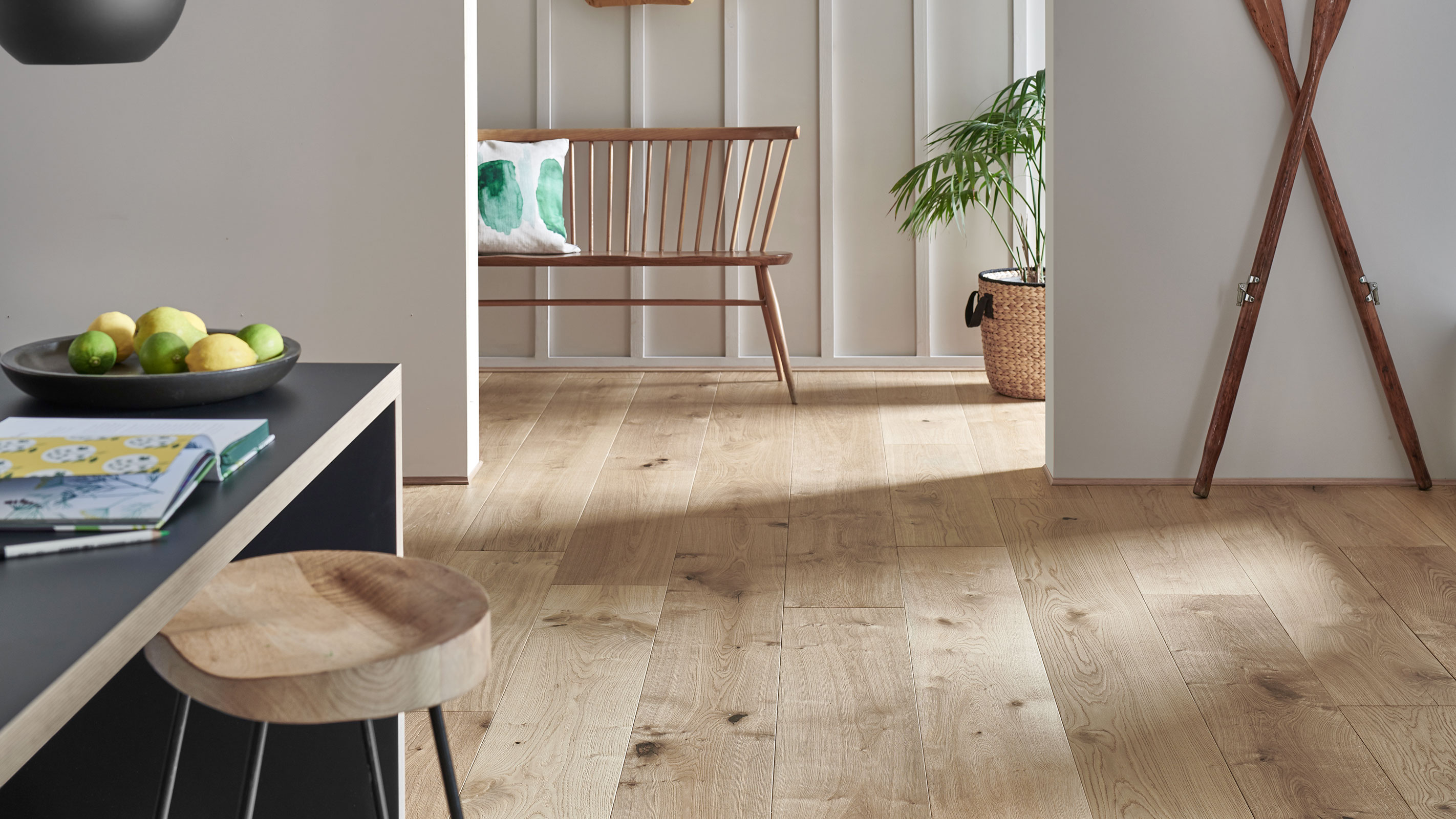
Go for parquet flooring to add visual interest
There is a huge interest in parquet and herringbone floors right now — and the kitchen is one spot where its popularity seemed to have hit its peak.
Not only will parquet add character and depth to the space but, due to its zig-zagging pattern, it is great at hiding dirt too. It isn't just solid wood flooring that is available as parquet or in herringbone and chevron designs — engineered timber floors come in this design too, as do many vinyl, porcelain and laminate wood look-a-likes.
"Parquet engineered wood flooring designs, including herringbone and chevron, are hugely popular in kitchens since they add contrast and interest to otherwise straight sight lines," explains Natalie Mudd. "Parquet flooring looks particularly stunning in larger kitchens with a central island which breaks up the floor space."
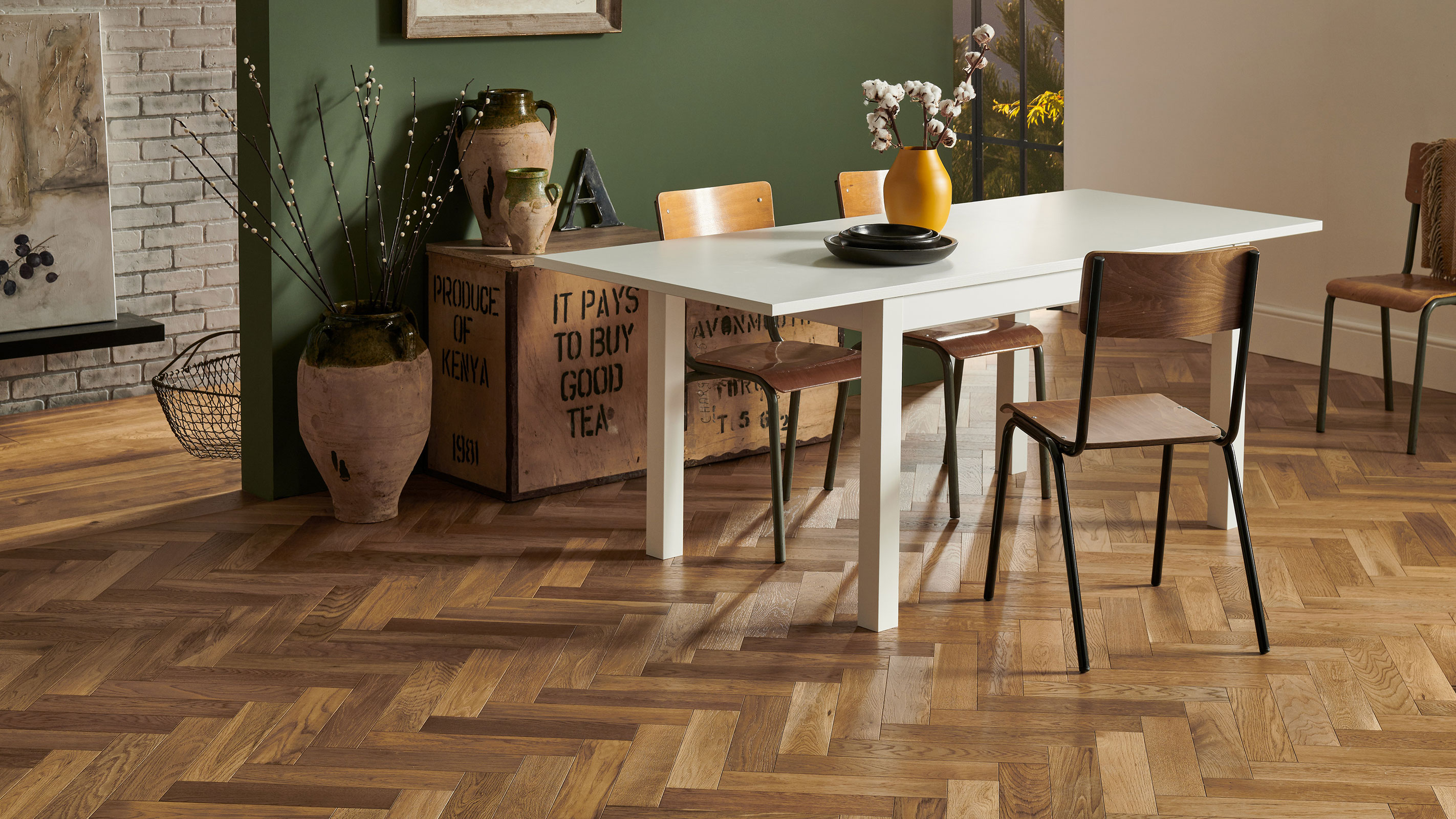
Consider vinyl as a cheaper, practical wood alternative
Although wood flooring can be used in kitchens and using an engineered product lessens the chance of movement, for those concerned about humidity, moisture and spills causing damage to their timber floor, it could be an idea to consider vinyl flooring instead.
There are now many types of vinyl flooring available, in a huge range of patterns, colours and designs and, like engineered timber, they are suitable for use over underfloor heating too. Some of the wood-effect vinyls are very realistic — particularly those with slightly textured surfaces.
“A less expensive option to a solid or engineered wood floor is to choose a vinyl with a wood effect finish," says Inga. "Vinyl is water resistant and works equally well in large and small kitchens. It’s straightforward to lay onto a clean, smooth, dry subfloor.
"For extra comfort select a design with a woven textile backing. This is not only comfortable underfoot but increases its durability. As well as being simple to clean and maintain vinyl is generally available in widths from 2m to 4m which means that there is little wastage."
Vinyl flooring can cost as little as £20-£25/m2 in sheet form or around £30-£65m2 for luxury vinyl tile (LVT).
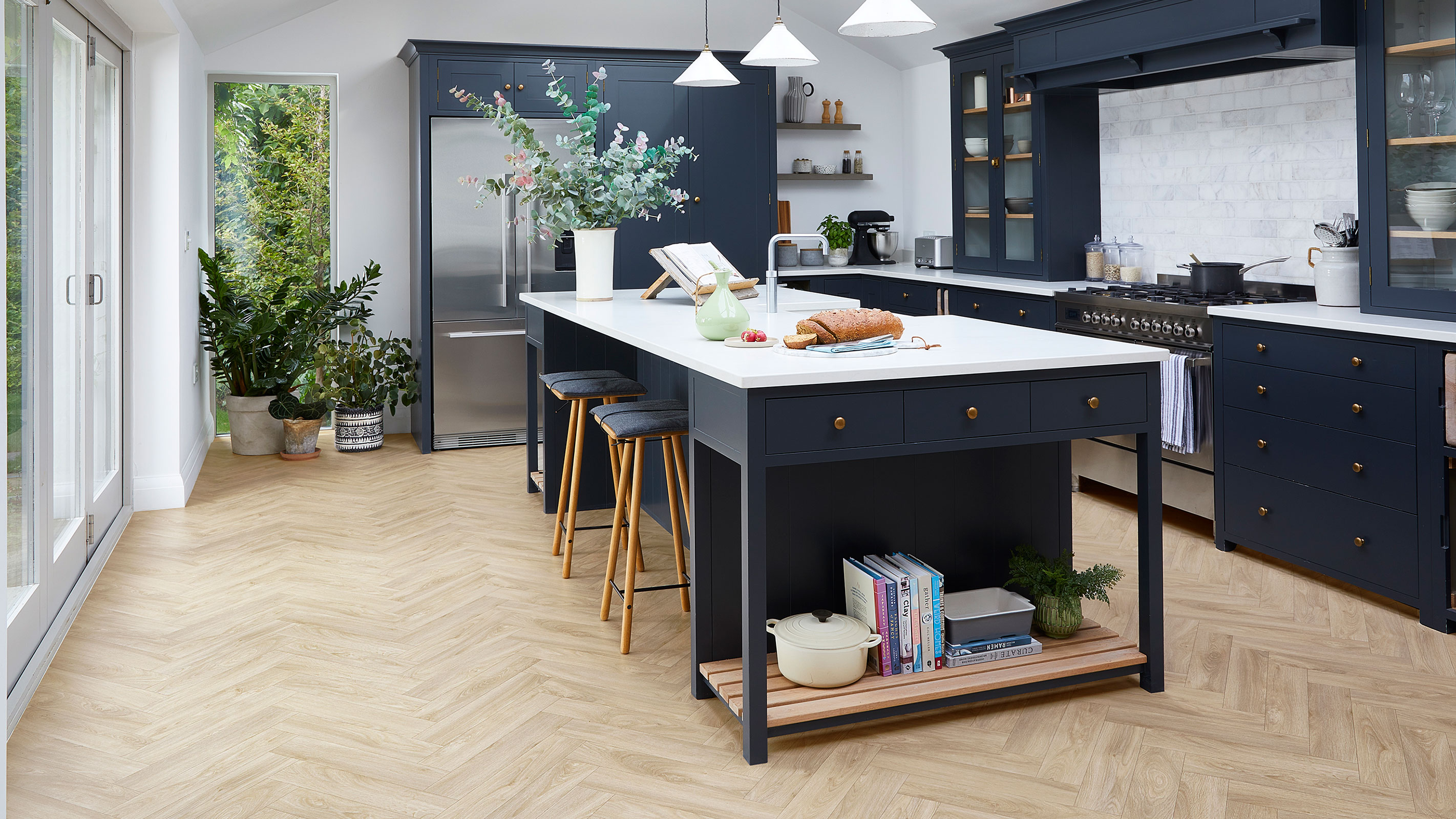
Don't discount laminate flooring in the kitchen
When it comes to wood flooring vs laminate, it is useful to bear in mind that laminate flooring really has come on hugely in the last 10 years or so and it can now be hard to distinguish it from real wood in some cases.
"There are many laminates that mimic the knots and grain of real wood and look as good as the real thing," agrees Inga.
When it comes to choosing a laminate floor for kitchens, do take care that the product you have your eye on will be suitable in spaces with high moisture levels — look for one with a AC5 rating.
"If selecting laminate for a kitchen floor then choose a range that has a water repellent finish and a click installation system that will help prevent water ingress," advises Inga. "Laminate requires a specific type of underlay so ensure you consult a flooring professional prior to installation.”
Another benefit of laminate is that it comes with a much lower price tag than either solid or engineered wood floors. Laminate starts from just £6/m² rising up to £25/m² or £60/m² for top-of-the-range products. Engineered wood flooring, on the other hand, costs from £30/m² but can easily cost more than £150/m².
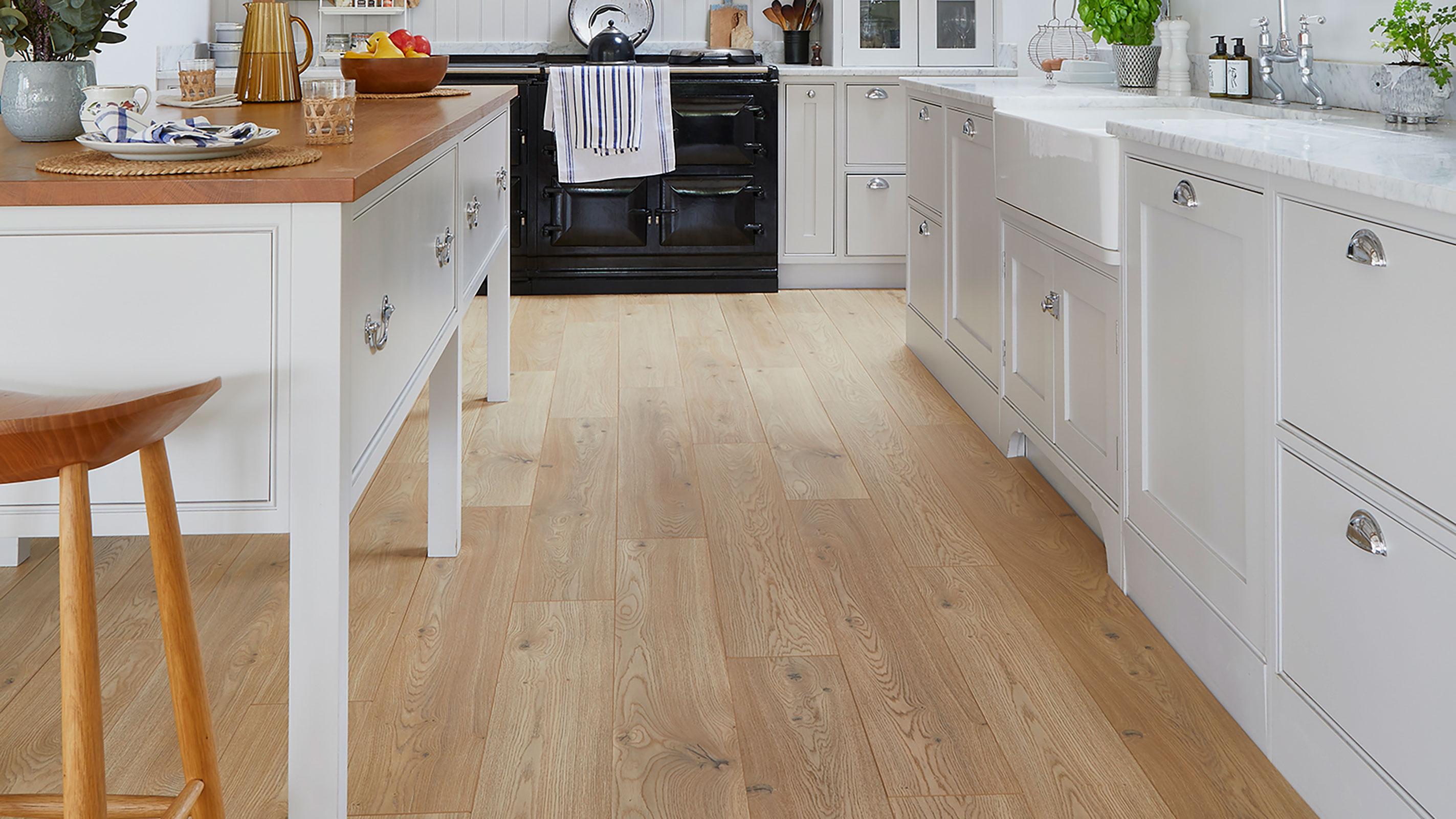
Get the Homebuilding & Renovating Newsletter
Bring your dream home to life with expert advice, how to guides and design inspiration. Sign up for our newsletter and get two free tickets to a Homebuilding & Renovating Show near you.
Natasha was Homebuilding & Renovating’s Associate Content Editor and was a member of the Homebuilding team for over two decades. In her role on Homebuilding & Renovating she imparted her knowledge on a wide range of renovation topics, from window condensation to renovating bathrooms, to removing walls and adding an extension. She continues to write for Homebuilding on these topics, and more. An experienced journalist and renovation expert, she also writes for a number of other homes titles, including Homes & Gardens and Ideal Homes. Over the years Natasha has renovated and carried out a side extension to a Victorian terrace. She is currently living in the rural Edwardian cottage she renovated and extended on a largely DIY basis, living on site for the duration of the project.

